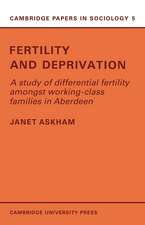Stage-Structured Populations: Sampling, analysis and simulation: Molecular Biology Intelligence Unit
Autor Bryan Manlyen Limba Engleză Paperback – 13 noi 2013
Din seria Molecular Biology Intelligence Unit
- 5%
 Preț: 663.61 lei
Preț: 663.61 lei - 18%
 Preț: 1229.10 lei
Preț: 1229.10 lei - 5%
 Preț: 1091.14 lei
Preț: 1091.14 lei - 24%
 Preț: 776.00 lei
Preț: 776.00 lei - 18%
 Preț: 1226.60 lei
Preț: 1226.60 lei - 15%
 Preț: 642.51 lei
Preț: 642.51 lei - 5%
 Preț: 1098.48 lei
Preț: 1098.48 lei - 15%
 Preț: 638.11 lei
Preț: 638.11 lei - 18%
 Preț: 944.99 lei
Preț: 944.99 lei - 5%
 Preț: 716.09 lei
Preț: 716.09 lei - 20%
 Preț: 552.99 lei
Preț: 552.99 lei - 5%
 Preț: 1096.62 lei
Preț: 1096.62 lei - 5%
 Preț: 1097.71 lei
Preț: 1097.71 lei - 18%
 Preț: 942.94 lei
Preț: 942.94 lei - 18%
 Preț: 1222.49 lei
Preț: 1222.49 lei - 5%
 Preț: 1408.97 lei
Preț: 1408.97 lei - 18%
 Preț: 947.04 lei
Preț: 947.04 lei - 5%
 Preț: 1094.60 lei
Preț: 1094.60 lei - 18%
 Preț: 945.79 lei
Preț: 945.79 lei - 24%
 Preț: 1053.41 lei
Preț: 1053.41 lei - 24%
 Preț: 786.20 lei
Preț: 786.20 lei - 24%
 Preț: 789.90 lei
Preț: 789.90 lei - 18%
 Preț: 945.62 lei
Preț: 945.62 lei - 5%
 Preț: 1095.90 lei
Preț: 1095.90 lei - 5%
 Preț: 1429.27 lei
Preț: 1429.27 lei - 24%
 Preț: 817.72 lei
Preț: 817.72 lei - 5%
 Preț: 1104.84 lei
Preț: 1104.84 lei - 18%
 Preț: 947.85 lei
Preț: 947.85 lei - 15%
 Preț: 640.88 lei
Preț: 640.88 lei - 18%
 Preț: 951.29 lei
Preț: 951.29 lei - 5%
 Preț: 1095.73 lei
Preț: 1095.73 lei - 18%
 Preț: 950.33 lei
Preț: 950.33 lei - 18%
 Preț: 946.55 lei
Preț: 946.55 lei - 18%
 Preț: 952.89 lei
Preț: 952.89 lei - 5%
 Preț: 714.63 lei
Preț: 714.63 lei - 18%
 Preț: 946.41 lei
Preț: 946.41 lei - 18%
 Preț: 947.85 lei
Preț: 947.85 lei - 18%
 Preț: 956.03 lei
Preț: 956.03 lei - 5%
 Preț: 1293.05 lei
Preț: 1293.05 lei - 5%
 Preț: 1098.63 lei
Preț: 1098.63 lei - 18%
 Preț: 944.19 lei
Preț: 944.19 lei - 18%
 Preț: 950.52 lei
Preț: 950.52 lei - 24%
 Preț: 782.72 lei
Preț: 782.72 lei - 18%
 Preț: 953.65 lei
Preț: 953.65 lei - 15%
 Preț: 640.06 lei
Preț: 640.06 lei - 5%
 Preț: 1610.67 lei
Preț: 1610.67 lei - 18%
 Preț: 947.35 lei
Preț: 947.35 lei - 18%
 Preț: 1231.32 lei
Preț: 1231.32 lei - 15%
 Preț: 649.06 lei
Preț: 649.06 lei - 18%
 Preț: 1231.16 lei
Preț: 1231.16 lei
Preț: 382.75 lei
Nou
Puncte Express: 574
Preț estimativ în valută:
73.26€ • 79.61$ • 61.58£
73.26€ • 79.61$ • 61.58£
Carte tipărită la comandă
Livrare economică 21 aprilie-05 mai
Preluare comenzi: 021 569.72.76
Specificații
ISBN-13: 9789401068666
ISBN-10: 9401068666
Pagini: 204
Ilustrații: XII, 187 p. 33 illus.
Dimensiuni: 155 x 235 x 11 mm
Greutate: 0.29 kg
Ediția:1990
Editura: SPRINGER NETHERLANDS
Colecția Springer
Seria Molecular Biology Intelligence Unit
Locul publicării:Dordrecht, Netherlands
ISBN-10: 9401068666
Pagini: 204
Ilustrații: XII, 187 p. 33 illus.
Dimensiuni: 155 x 235 x 11 mm
Greutate: 0.29 kg
Ediția:1990
Editura: SPRINGER NETHERLANDS
Colecția Springer
Seria Molecular Biology Intelligence Unit
Locul publicării:Dordrecht, Netherlands
Public țintă
ResearchCuprins
1 Stage-structured populations.- 1.1 Introduction.- 1.2 Stage-frequency data.- 1.3 Key factor analysis.- 1.4 Case studies.- 2 Sampling for population estimation.- 2.1 Introduction.- 2.2 Populations and samples.- 2.3 Simple random sampling.- 2.4 Determining sample sizes with simple random sampling.- 2.5 Stratified random sampling.- 2.6 Ratio estimation.- 2.7 Regression estimation.- 2.8 Cluster sampling.- 2.9 Systematic sampling.- 2.10 Multi-stage sampling.- 2.11 Sampling for stage-frequency data.- 2.12 Sampling species assemblages.- 2.13 Special sampling methods.- Exercises.- 3 Maximum likelihood estimation of models.- 3.1 The method of maximum likelihood.- 3.2 Models for count data.- 3.3 Computer programs.- 3.4 Measuring goodness-of-fit.- 3.5 Comparing models.- 3.6 The heterogeneity factor.- 4 Analysis of multi-cohort stage-frequency data.- 4.1 Multi-cohort stage-frequency data.- 4.2 Temperature effects.- 4.3 Effect of mortality on stage durations.- 4.4 Methods for analysing multi-cohort stage-frequency data.- 4.5 Assessing estimates by simulation.- 4.6 The Kiritani—Nakasuji—Manly (KNM) method of analysis.- 4.7 The KNM method with iterative calculations.- 4.8 The Kempton method of estimation.- 4.9 Variations of the Kempton type of model.- 4.10 The Bellows and Birley model.- 4.11 Comparison of models.- Exercises.- 5 Analysis of single cohort stage-frequency data.- 5.1 Types of single cohort data.- 5.2 Analysis using multi-cohort methods.- 5.3 Data without mortality.- 5.4 Non-parametric estimation.- 5.5 Parametric models for estimation.- 5.6 Estimating the durations of stages.- Exercises.- 6 Matrix and other models for reproducing populations.- 6.1 Continually reproducing populations.- 6.2 The Bernardelli—Leslie—Lewis model.- 6.3 Lefkovitch’s model forpopulations grouped by life stages.- 6.4 Usher’s model.- 6.5 Further generalizations and extensions.- 6.6 Sampling variation and other sources of errors.- 6.7 Discussion.- 6.8 Other models for populations with continuous recruitment.- Exercise.- 7 Key factor analysis.- 7.1 Populations observed over a series of generations.- 7.2 Density-dependent survival.- 7.3 The Varley and Gradwell (1960) graphical method of key factor analysis.- 7.4 Extensions to the Varley and Gradwell approach.- 7.5 Detecting density-dependent k values.- 7.6 The Manly (1977) model for key factor analysis.- 7.7 The relative merits of different methods of key factor analysis.- 7.8 Using simulation with key factor analysis.- 7.9 Testing for delayed density-dependent mortality.- 7.10 Recent developments.- 7.11 Computer program.- Exercise.- 8 Case studies.- 8.1 Introduction.- 8.2 The sheep blowfly Lucilia cuprina.- 8.3 The nematode Paratrichodorus minor.- 8.4 The pink cotton bollworm moth Pectinophora gossypiella.- 8.5 The southern pine beetle Dendroctonus frontalis.- 8.6 The grey pup seal Halichoerus grypus.- References.- Author index.















